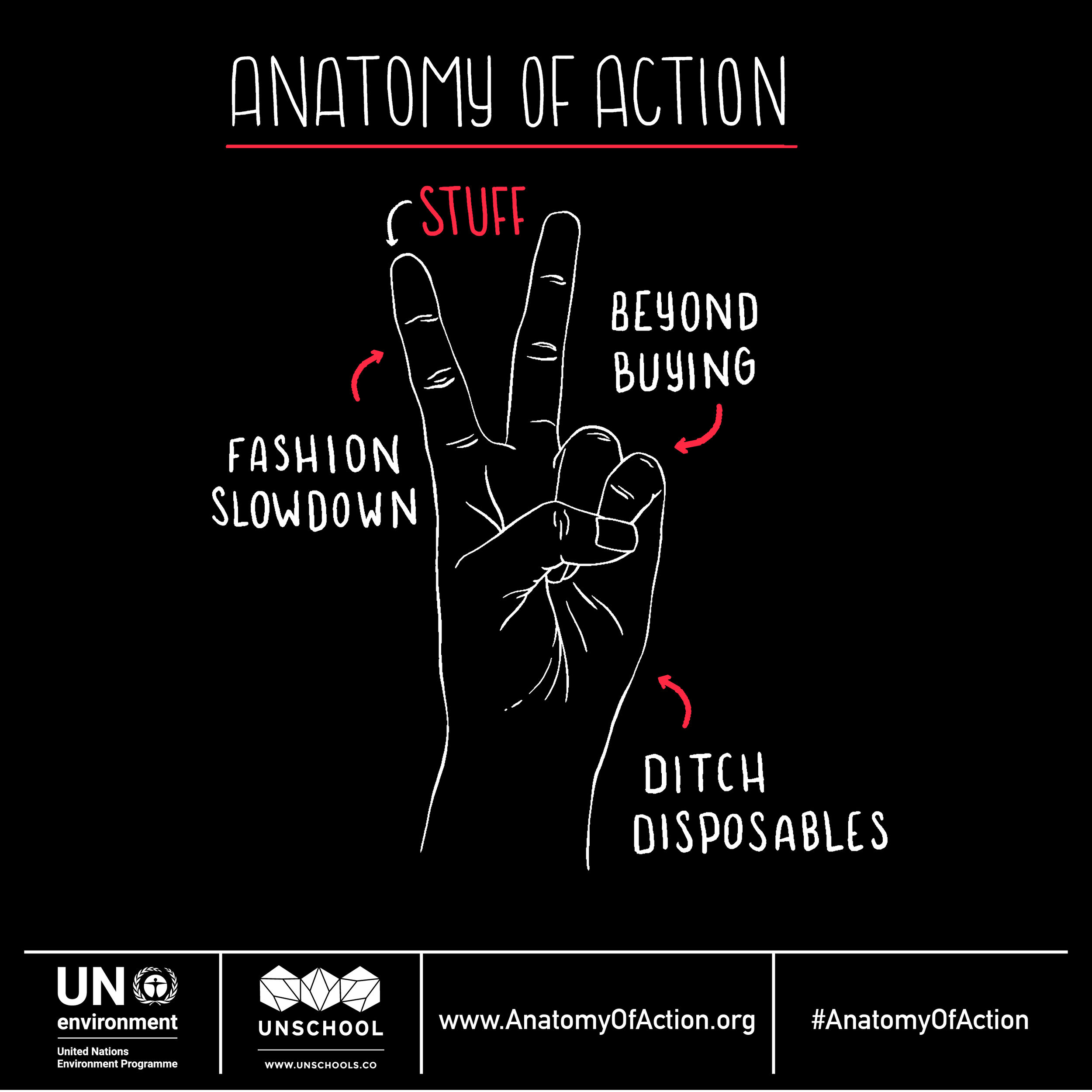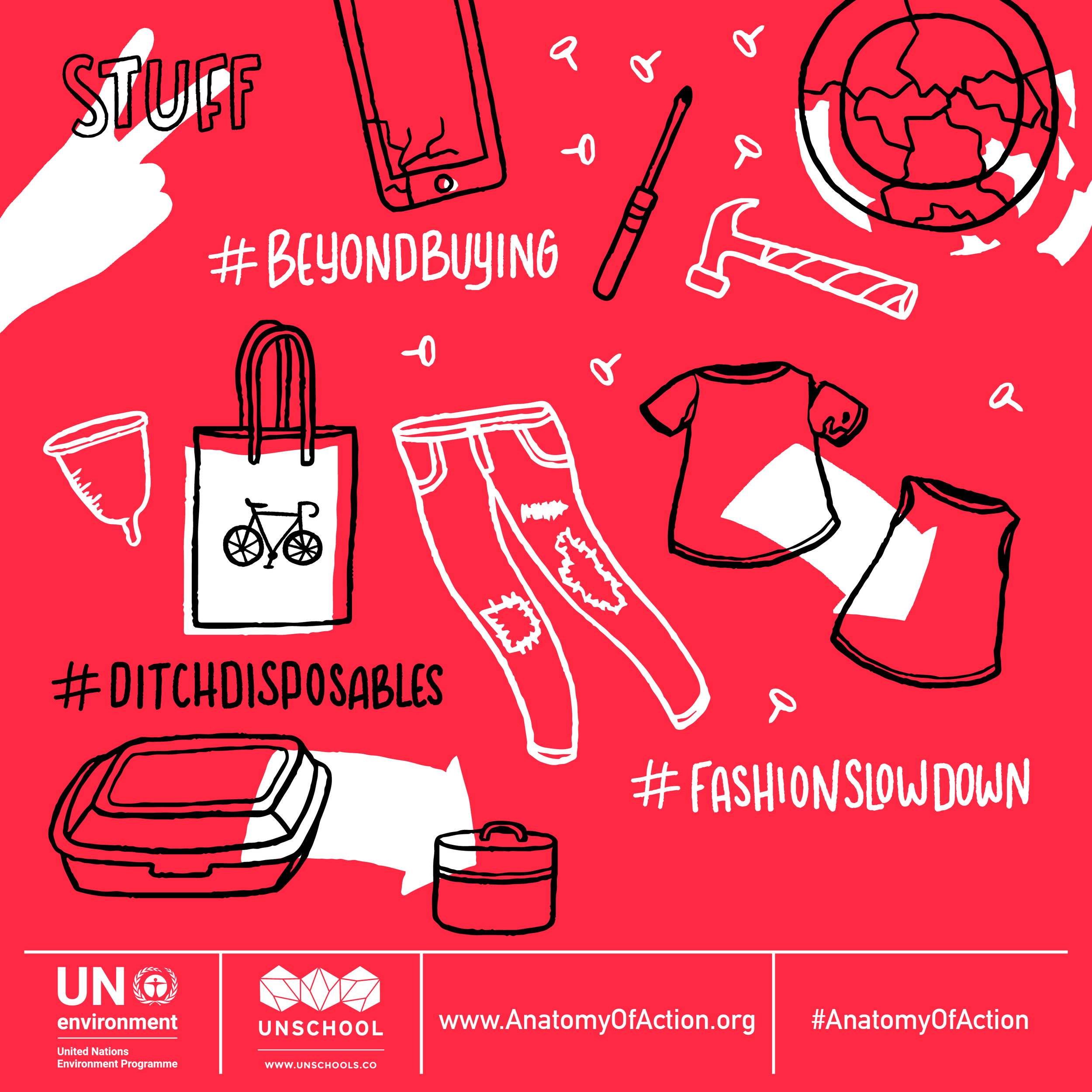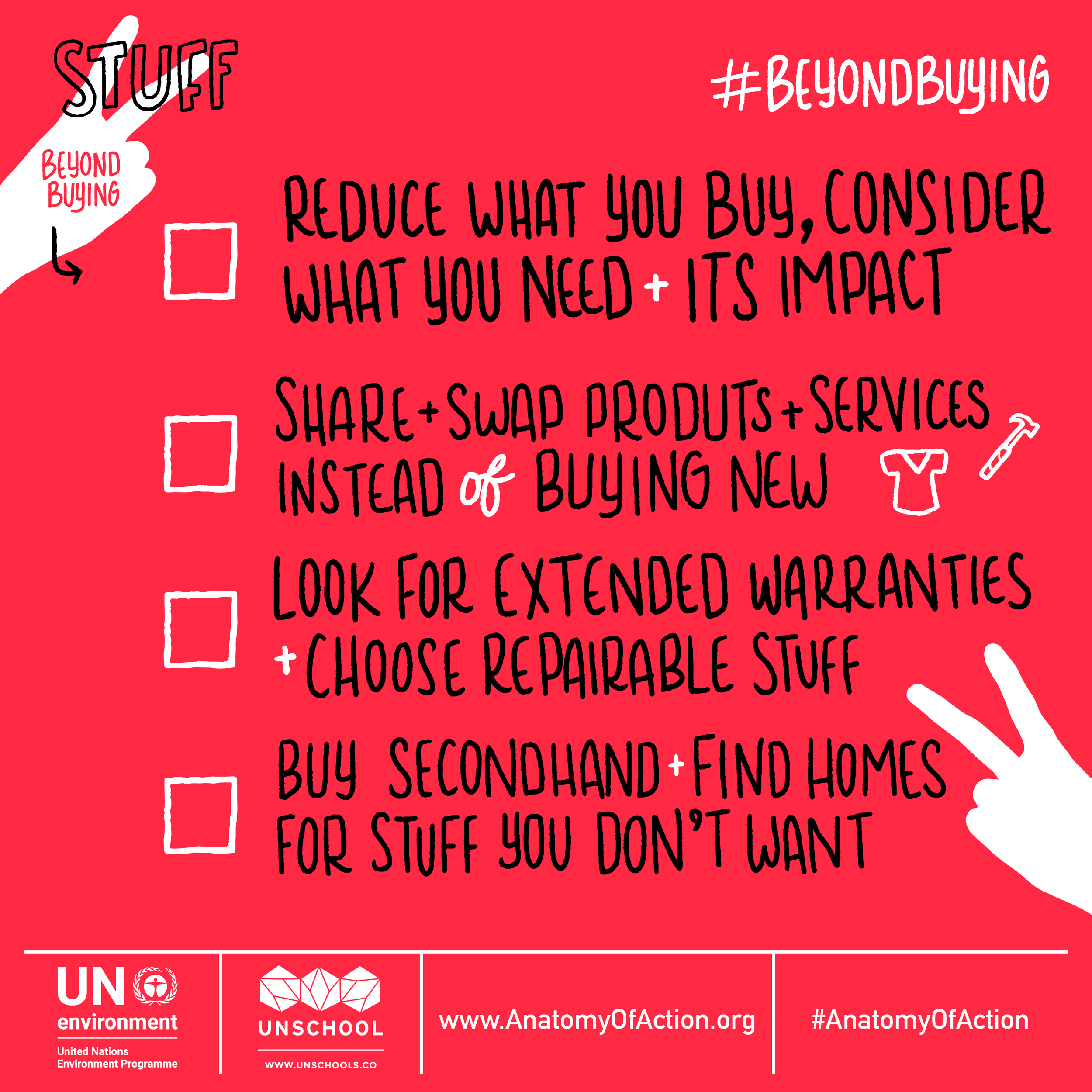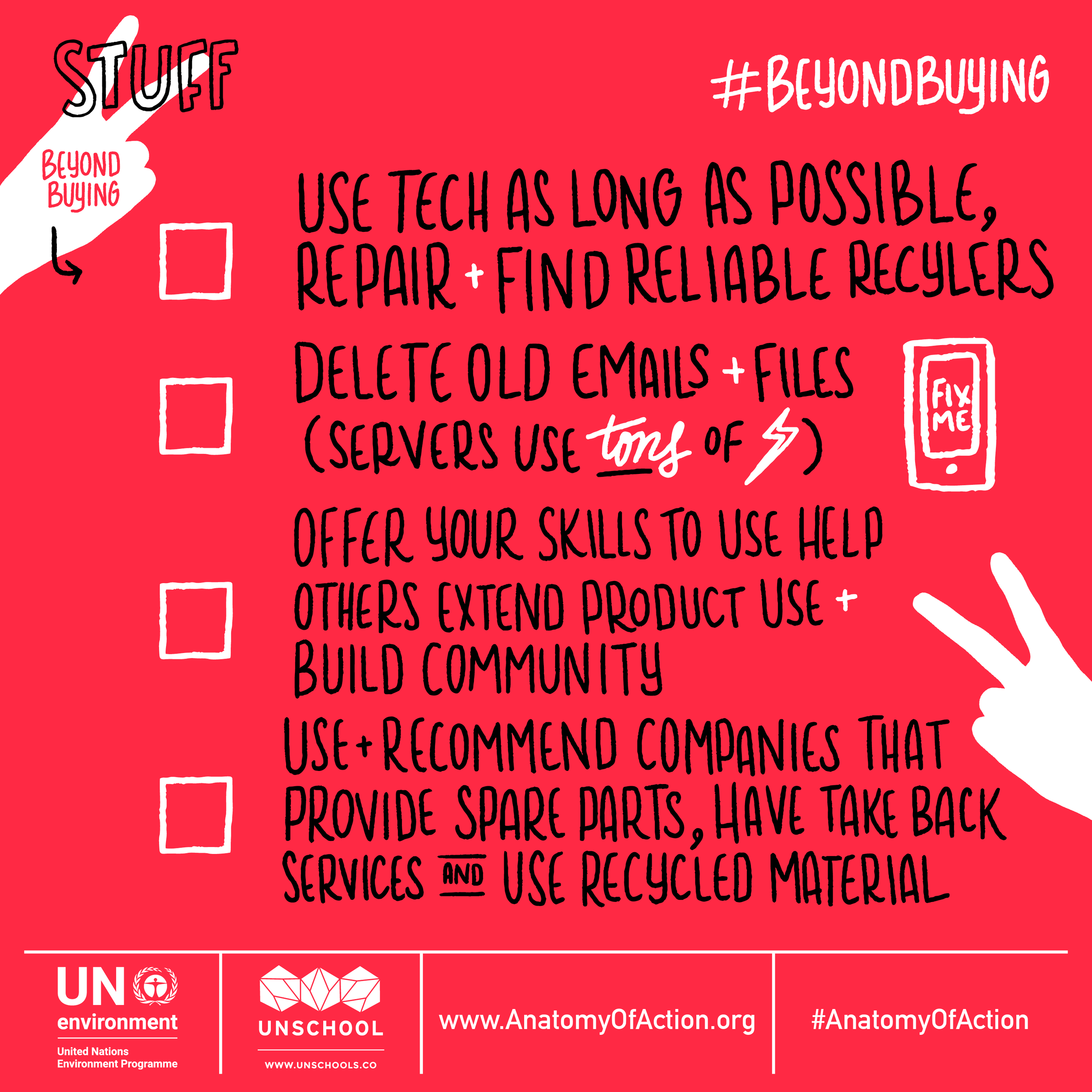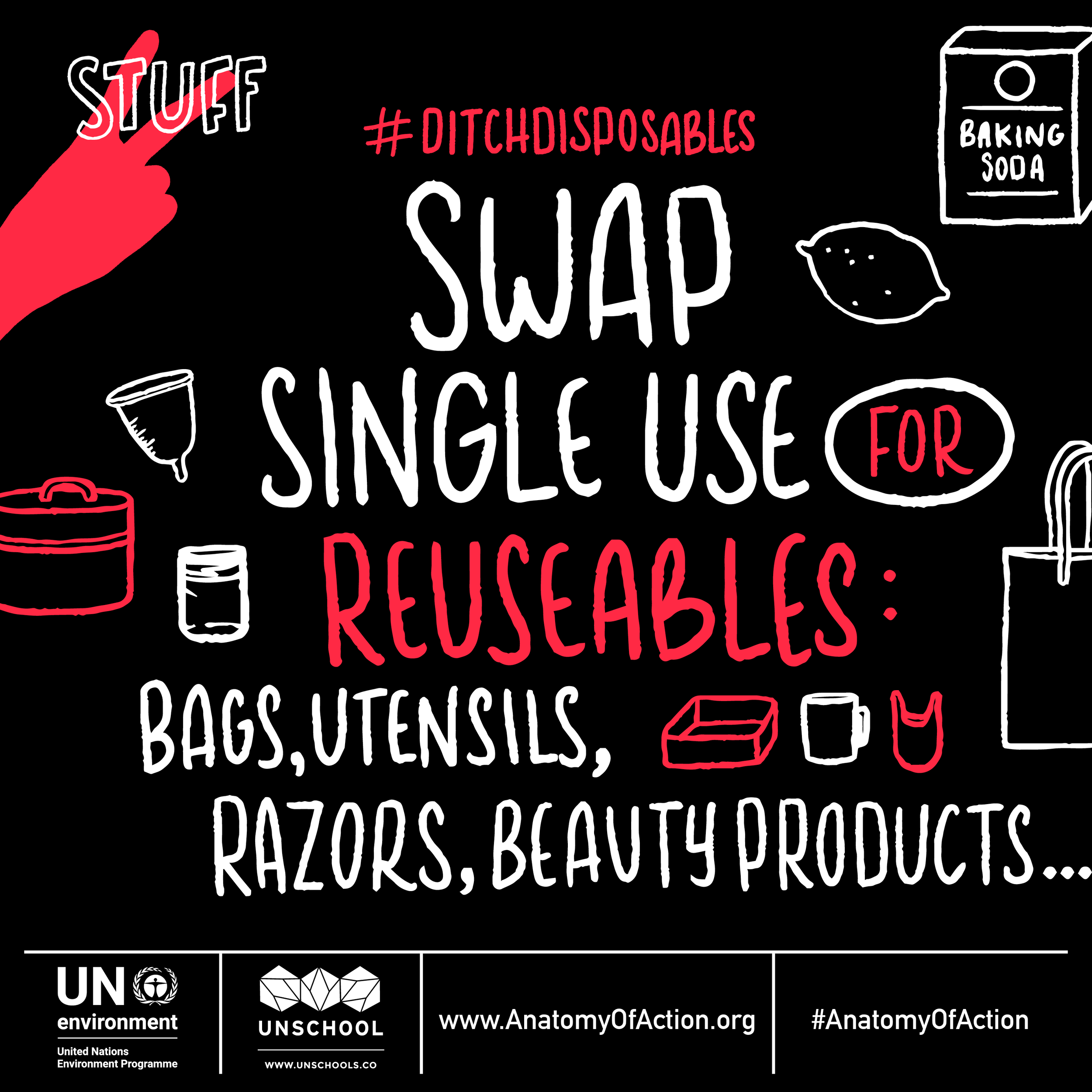Stuff! It is everywhere, all around us, fulfilling needs and helping to make our modern lives possible. But SO much stuff is wasted, useless, or unnecessary, and the impact of the material world is astronomical. Wherever you are right now, you can look around and see a bunch of stuff that has been manufactured, purchased, and at some point, will be waste - this linear economy has resulted in heaps of unintended negative consequences on the planet, many of which we are now seeing come around to hurt us - like ocean plastic waste.
It’s hard not to get overwhelmed when thinking about the amount of “stuff” in this world. The average American household contains 300,000 items, an average British 10-year-old child owns 238 toys but usually only plays with 12 of them, and 77 million automobiles will have been sold by the end of 2019. With the rise of cheap manufacturing and convenience-driven shopping (free 2-day shipping, anyone?), stuff is now as ubiquitous in our lives as food, only it doesn’t nourish and sustain us but instead, it often simply takes up space — first in your home, then in a giveaway box or most likely, a landfill, with 99 percent of stuff being trashed within 6 months! We have become obsessed with buying sh*t we don’t necessarily need, and the economy is fueled by the hyper-consumption loop that drives the faulty GDP system. That’s why, for the second category of the Anatomy of Action, we tackle how to improve our consumption habits with thinking beyond buying, slowing down fashion, and ditching disposables.
Action 1: Beyond Buying
What’s behind so many of the negative environmental impacts we’re grappling with today? Although there’s no one singular, simple answer, we’d be remiss not to look at the linear economy that we’ve designed over the last century in order to meet human wants and needs. Our current economy is based on a waste-based system of production where we take raw materials and natural resources out of nature, process them into usable goods to meet human needs, and then discard them back into giant holes in the ground that, ironically, were often where we took the raw materials from to begin with.
This entire system is in opposition to the natural systems that sustain life on Earth — which are circular and regenerative — and it’s counterintuitive to the way we function as living organisms. For example, we all require nutrients to survive, which is part of the beautifully-designed system of nutrients cycling through bodies and back into the ground to grow the next generation of food; this nutrient cycle is one of the fundamental ecosystems that makes life on Earth possible. Basically, humans designed a broken system that needs waste to sustain itself, and thus everything is intended to constantly lose value after it's purchased. Our linear economy does not fit in a circular world, and we can instead find ways of circumnavigating this cycle and activating our agency within the economy by buying better things.
This needs to be emphasized when we start to think “Beyond Buying”, as we cannot sustain the wasteful, reductive linear economy and thus need to transition to a circular economy in order to shift the status quo of our consumption problem. While many people automatically think that transitioning to circular systems design will result in monetary losses, it’s actually the opposite in that a circular economy offers some huge financial incentives. Current research indicates that the material saving potential alone, for example, is estimated at 500 billion € per year for the European industry, and the job creation potential of remanufacturing and recycling in Europe is estimated at one million new jobs!
Along with rethinking how we consume stuff and implementing circular design practices, there are also huge opportunities in sharing, swapping, repairing, and repurposing the things that we already have. Consider the fact that on average, cars in North America and Western Europe are only in use 8% of the time, or that the average electric drill is used 6 to 13 min over its lifetime. It makes absolutely no sense as to why we all need to own so many items individually, and it’s much more practical to consider collaborative consumption.
Similarly, we’ve also become accustomed to a throw-away economy in which instead of repairing our goods, we discard them and then replace them instead. This isn’t all the fault of the consumer, however — 77% of EU consumers say they’d rather repair goods than buy new ones, and indeed, there are systems issues with planned obsolescence and enforced disposability that encourage this uptick in buying new devices. This is especially true with tech gear and the trend of replacing smart phones on an annual basis (there are now more phones on this planet than people!), which is a massive missed economic opportunity among its other issues. In fact, a United Nations University report estimates “the value of the recoverable materials in discarded electronics was $52 billion dollars in 2014 alone.” Similarly, if the industry were better regulated and made phones easier to take apart and recapture, then the cost of remanufacturing them could be reduced by 50% per device.
So, as you can see through this small snapshot, there are huge opportunities in moving away from this exploitative economy and moving beyond buying. This is, in short, what the circular economy is all about: meeting our needs with new sustainable product designs, service delivery models, and new approaches to business where we get better experiences with less stuff. To start, we can find ways of introducing things into our daily lives that have more value and last longer, reduce disposability, and maximize material recapture.
Whilst we wait for all producers of goods and services to adopt these new approaches, consumers of all walks of life can be more conscious of what they need, what they are buying, and how they value the things that fill our lives. Increasing the usable life by repairing, sharing, reselling, and reducing helps reduce the need for new goods. If you can, invest in goods with longer warranties and design durability, and find companies that offer buyback and repair schemes for their products along with swapping and sharing things you need. Consider what you need before you buy products so that you can ensure you acquire things that will last longer, be used multiple times, and are intended to be in the economy for as long as possible before being waste.
#BeyondBuying Everyday Actions:
Consider what you really need and what impacts these have on the planet before making buying stuff and reduce what you buy
Continue or start sharing, swapping things like appliances, tools, clothes, talents and services
For new purchases, look into how you can get what you need via a service or a product that lasts longer and has been made sustainably
Find things with extended warranties and that can be repaired, and then make sure you repair things
Buy beautiful second hand things and find new homes for things you no longer want
For technologies and gadgets use them longer, repair and donate them and ensure you find a reliable recycler at the end of their life
Delete old emails and other files stored on the cloud (servers use heaps of energy)
Offer your technical skills and talents to extend product use, help others, and build a sense of community
Recommend and buy from companies that provide spare parts to repair, that offer take back services or use recycled materials in production
Action 2: Fashion Slow Down
One of the most pervasive subcategories of stuff that accumulates and creates waste is found in textiles. Fashion is a hyper-fast, resource-intensive industry that impacts nearly everyone on the planet in some way. We all wear clothes not only for functionality, but also to express a certain style and identity. But with global clothing production doubling in the last 15 years, the fast fashion phenomenon exacerbates labor conditions (excessive dust, heat, rodents, lack of sanitation, etc.), and product quality is pushed as low as possible by brands to make inventory on a weekly basis. And then, after the newest styles are purchased for the thrill of newness and a low price, they often just sit in one’s closet, unworn. According to research by the Ellen MacArthur Foundation, “...the average number of times a garment is worn before it ceases to be used has decreased by 36% compared to 15 years ago, and the same pattern is emerging in China, where clothing utilisation has decreased by 70% over the last 15 years.”
You know what happens next — after garments sit unworn in a closet for some time, they are then shipped off to the landfill whenever a tidying-up urge hits. Recycling isn’t happening: 84% of all textile waste is sent directly to landfills. Of course, all of this negatively impacts climate conditions, whereas “reuse of clothing saves 29kg CO2e per kg of clothing compared to recycling and 33kg CO2e compared to disposal.” When we configure the economics of this environmental disaster, we find that “globally, customers miss out on USD 460 billion of value each year by throwing away clothes that they could continue to wear and some garments are estimated to be discarded after just seven to ten wears.”
You can avoid contributing to this by breaking the vicious cycle perpetuated by constantly changing clothes by finding responsible brands that support the betterment of workers and the environment or by buying second hand. In becoming a conscious and responsible consumer through the power of your decision making, you will help the environment and society in significant ways.
#FashionSlowdown Everyday Actions
Celebrate being unique - buy vintage, redesign old clothes, create a core basic or ‘capsule’ wardrobe, and be bold in your fashion choices
Give your clothes a second chance: share, reuse, repair, recycle, sell, and donate high-quality fashion for second-hand use
Think long-term: buy quality clothes that last and take care of them. Today’s new pieces are tomorrow's vintage treasures
Let brands know when you are not happy with their practices and help encourage them to move towards sustainable production
Use your consumer power to buy better clothes and to increase the availability of more sustainable fashion options
Ask brands about how best to take care of their clothes, how they produce and source, and how they are committed to sustainability
Action 3: Ditch Disposables
We have a collective global challenge unprecedented in the history of humans on this Earth. We have designed ourselves into a tightly-wound system of disposability that is wreaking havoc on the systems that sustain us all. No human is immune to these outcomes from our collective actions, as no one can deny that they need food, air, and water to survive and thrive. Thus, we are all implicated in the necessity to dramatically redesign our manufacturing, production, and consumption systems to be post disposable.
From the oceans to the air, our natural systems have become innocent victims of our hyper-disposable cycles of meeting human needs. This is not an alarmist warning — this is a biophysical realty of the planet we all share. The data tells the story here; with over 320 million tons of plastic being consumed globally and more plastic produced in the last decade than ever before, plastic is infiltrating all of our natural systems, especially the ocean with more than 8 million tons of it leaking into the ocean each year, thanks to poor disposal practices, broken recycling systems, and the lack of waste management in emerging economies where plastic is pervasive.
The UNEP reported in 2018, “Only nine percent of the nine billion tonnes of plastic the world has ever produced has been recycled. Most ends up in landfills, dumps or in the environment. If current consumption patterns and waste management practices continue, then by 2050 there will be around 12 billion tonnes of plastic litter in landfills and the environment. By this time, if the growth in plastic production continues at its current rate, then the plastics industry may account for 20 percent of the world’s total oil consumption.” And we’re just scratching the surface on how all of this is also impacting human health, as we’ve recently learned that 90% of table salts contain microplastics and the average adult consumes approximately 2,000 microplastics per year through salt.
All over the world, our daily lives are overwhelmed with single-use products and plastics, from packaging to beverage cups and bags. As shared by UNEP, "The most common single-use plastics found in the environment are, in order of magnitude, cigarette butts, plastic drinking bottles, plastic bottle caps, food wrappers, plastic grocery bags, plastic lids, straws and stirrers, other types of plastic bags, and foam take-away containers. These are the waste products of a throwaway culture that treats plastic as a disposable material rather than a valuable resource to be harnessed."
Disposable products are not just hazardous for the environment but also costly to remove and hard to recycle. By ditching disposables in whatever way you can, you are supporting the global movement to go #zerowaste and sending signals to producers and stores that we don't want plastic in our oceans and littering our streets. This is more important than ever before with the recent global shakeup stemming from China refusing to take more recycling — by 2030, it’s estimated that 111 million metric tons of plastic waste will be displaced due to this new law. But the good news is that from personal beverage containers to shopping in bulk and even making your own cleaning products, there are hundreds of micro actions you can take to support the global trend towards a post disposable future.
#DitchDisposables Everyday Actions:
Swap daily disposables such as straws, bags, coffee cups, take out food containers, forks, razors, sanitary products for reusable alternatives, you will save money in the long run
Continue or start to buy at bulk food stores and bring your own containers and bags to take products home in
Carry your own vessel for water and hot drinks
Rethink food storage to eliminate plastic baggies and wrap, you can swap to reusable containers and beeswax wraps
Clean greener- from toothpaste to household cleaning products there are alternative and often cheaper ways of getting things clean such as bicarb soda and vinegar
Replace disposable hygiene products with reusable ones, such as swapping pads & tampons for the menstrual cups and moon pads
Consider ways to refill products like cleaning and household liquids in bulk to reduce packaging
Use your consumer power where you shop, eat, and work to voice the change you want to see and reduce disposability from our lives!
Why the AoA?
There are no simple solutions to complex problems, and the consumption issues we face are indeed complex. While the global environmental and social issues being big and often overwhelming, it is important to be reminded that they are in part the outcomes of many individual actions. So, the choices we each make as individuals, as workers, and as members of societies have the potential to reinforce undesirable actions or to create the opportunity for new, more sustainable solutions to emerge.
The actions outlined in the Anatomy of Action are the top-level actions any individual can take to help support the global shift toward a more sustainable and regenerative future. No matter who you are, every action you take has an impact. By taking these more considered actions, you can contribute to a global movement for a more sustainable future. There are many other things you can do; this list is by no means an exhaustive account of all the aspects of our lives where we need to tackle to meet the SDGs. But it’s a starter list that any individual, anywhere can take action on to help make a positive future for all of us!


